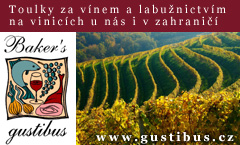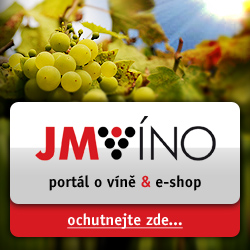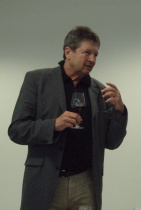 An info-trip for FIJEV wine writers to the Rheinhessen wine region, organised by our German colleague Wilfried Moselt, took place between 16-19 May 2007. 17 wine writers from ten countries (Germany, UK, France, Belgium, The Netherlands, Switzerland, Czech Republic, Finland, Slovenia and China) made their individual ways to the nearest airport or direct to the excellent small Hotel Pfaffenhofen in the quiet village of Schwabenheim between Bingen and Mainz. A reception and dinner at the hotel were hosted by Thomas Schätzel and Bernd Kern representing the organisation Rheinhessenwein e.V. - our hosts - and attended by the gracious Rheinhessen wine princess, Christine Huff from Nierstein. An info-trip for FIJEV wine writers to the Rheinhessen wine region, organised by our German colleague Wilfried Moselt, took place between 16-19 May 2007. 17 wine writers from ten countries (Germany, UK, France, Belgium, The Netherlands, Switzerland, Czech Republic, Finland, Slovenia and China) made their individual ways to the nearest airport or direct to the excellent small Hotel Pfaffenhofen in the quiet village of Schwabenheim between Bingen and Mainz. A reception and dinner at the hotel were hosted by Thomas Schätzel and Bernd Kern representing the organisation Rheinhessenwein e.V. - our hosts - and attended by the gracious Rheinhessen wine princess, Christine Huff from Nierstein.
On Ascension Day (Christi Himmelfahrt) we were taken to the family winery of Michael Teschke in the hamlet of Laurenziberg near Gau Algesheim. Atypically the family were farmers originating from East Prussia, escaping to East Germany after the war and thence to the West. They began planting vines here in 1953. And have lately specialised in the Silvaner grape, seeing the way plantings of this successful variety were gradually diminishing in the face of upstarts such as the newly trendy Dornfelder.  Michael, who abandonded his military career to take over the reins from his older brother when their father died, wanted to prove that great things can be achieved with this traditional grape variety. The tasting began with a lightly frizzante Secco Perlwein 2004 and a Sylvaner Gutssekt 04 Primus, elegant sparkler made by méthode champenoise. Incidentally, Michael prefers the Sylvaner (as opposed to the German Silvaner) spelling, his wife's name being Sylvia, he aims for a wine with more sunshine... Michael, who abandonded his military career to take over the reins from his older brother when their father died, wanted to prove that great things can be achieved with this traditional grape variety. The tasting began with a lightly frizzante Secco Perlwein 2004 and a Sylvaner Gutssekt 04 Primus, elegant sparkler made by méthode champenoise. Incidentally, Michael prefers the Sylvaner (as opposed to the German Silvaner) spelling, his wife's name being Sylvia, he aims for a wine with more sunshine...
A raft of superb Sylvaners in different styles and vintages then followed. The grape harvest at the estate is usually carried out in three stages: green harvest in August, first harvest for his Classic styles at the end of September and then comes late harvesting of October, November and sometimes even in December, as in the Sylvaner Selection styles, such as the 0814 and 0815. (Note: 0815 or Nullachtfünfzehn was a machine gun used in World War I and ironically means "nothing special" and 0814 or Nullachtvierzehn is, according to Michael, "its small brother"...) We finished the Sylvaner tasting with the Spätlese Trocken Sylvaner 2003 which spent 16 months in the French barriques. It had an intense flavour of ripe pears and quince jelly laced with exotic spices and a hint of white chocolate. These may be the best wines made of this variety in all Germany, Franken included. All the Teschke production (some 55,000 bottles) is sold and consumed in Germany (but some bottles have now sneaked into the Czech Republic!). 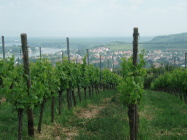
One point of interest that was noticed here as well as in other go-ahead wineries. This was the discarding of the traditional kabinet, late harvest and other lower special-attribute ratings, which in these days of global warming are seen as an almost irrelevant obsession with sugar levels in that nearly all grapes now reach at least kabinet status. Instead the simpler-to-understand Selection Rheinhessen category is used, other than for the moment the upper reaches of sugar levels (BA and TBA) which are still used. If the watchword here is fresh, light wines, then our next visit proved to show another philosophy entirely, highly alcoholic wines with a barrique emphasis. This is the Weingut Peth-Wetz in Bermersheim. High-end unfiltered reds is the principal style. The tasting commenced with a Silvaner ice wine 2004 barrique which was served as an aperitiv and served at the tasting and dining room of the winery. Hartmut Peth has made wine for 8 years on 2 hectares having studied vini-viticulture widely across the globe. These wines reach a different market segment, where they are undoubtedly successful - big, bold international styles of Chardonnay and Pinot Noir, which found much favour with some. They were accompanied by fine food from a local restaurant, Weingewölbe, owned by Stefanie and Jean-Marie San Martin, the latter having trained under the legendary Paul Bocuse in France. This was an excellent combination of fine French dishes including a lobster bisque and lamb en croûte to marry with these very specific types of Rheinhessen wine.  The afternoon visit took us to the Haus der Landwirtschaft in the town of Alzey. Here in the Weinbauamt, the Agricultural control centre, every year 30,000 samples or roughly 2-2.5 million hectolitres of wine undergo technical controls. Rheinhessen has a total of 4 000 producers who make wine in bottle. After a welcome Pinot cuvée sekt from Strubel-Roos, the very amiable Dr. Tauschl, led us through a tasting of 17 wines (including 3 reds) in an unusual blind tasting, to evaluate their bouquet, taste, harmony and persistence in a flat 20-point scale, not related to the usual marking system. Included were a range of varieties - Silvaner, Scheurebe, Weissburgunder as well as some fine Rieslings, the older lush samples full of beloved petroleum notes, which we were informed are out of favour with new consumers, who seek out new flavours full of fresh and fruity notes as is the general modern trend. Two excellent wines from the Huxelrebe, Trockenbeerenauslese 1990 and Beerenauslese 2003, should not be forgotten, especially as these, from Weingut Dr. Hinkel of Framersheimand Weingut Schales of Florsheim-Dalsheim, came first and second respectively. Third was a Riesling Eiswein from Weingut Neef-Emich, Bermersheim. The afternoon visit took us to the Haus der Landwirtschaft in the town of Alzey. Here in the Weinbauamt, the Agricultural control centre, every year 30,000 samples or roughly 2-2.5 million hectolitres of wine undergo technical controls. Rheinhessen has a total of 4 000 producers who make wine in bottle. After a welcome Pinot cuvée sekt from Strubel-Roos, the very amiable Dr. Tauschl, led us through a tasting of 17 wines (including 3 reds) in an unusual blind tasting, to evaluate their bouquet, taste, harmony and persistence in a flat 20-point scale, not related to the usual marking system. Included were a range of varieties - Silvaner, Scheurebe, Weissburgunder as well as some fine Rieslings, the older lush samples full of beloved petroleum notes, which we were informed are out of favour with new consumers, who seek out new flavours full of fresh and fruity notes as is the general modern trend. Two excellent wines from the Huxelrebe, Trockenbeerenauslese 1990 and Beerenauslese 2003, should not be forgotten, especially as these, from Weingut Dr. Hinkel of Framersheimand Weingut Schales of Florsheim-Dalsheim, came first and second respectively. Third was a Riesling Eiswein from Weingut Neef-Emich, Bermersheim.
The evening finished with a trip to the appropriately named and extremely popular Heiliggeist 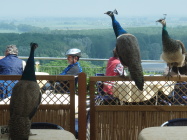 restaurant in a deconsecrated Roman Catholic Church in the centre of old Mainz. Absolutely full for the bank holiday, this restaurant offered much seasonal asparagus among other dishes. restaurant in a deconsecrated Roman Catholic Church in the centre of old Mainz. Absolutely full for the bank holiday, this restaurant offered much seasonal asparagus among other dishes. The following morning saw us in the National Winery in Oppenheim, the wine and horticultural school, for a presentation of key facts and figures relating to local and national trends. One such is the production of lighter fruitier wines, which as we have already seen are the desired style for the modern customer, who likes to drink wines as youthful as possible (an exception that maybe proves the rule was our second visit yesterday of course). German wine consumption is apparently decreasing though customers have moved upmarket and are thus spending more. 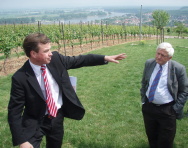 Rheinhessen is the largest wine region in Germany with around 26 000 ha of vineyards, located within the Mainz-Bingen-Worms triangle on the left bank of the Rhine. The main white-wine varieties are: Müller-Thurgau 47% (16% of total plantings in the region), Riesling 25%, Silvaner 6%. Then we come to the reds and Dornfleder, a grape that only came to being in the last 30 years, which now accounts for an incredible 80% of red grape varieties (13% of total plantings), while Pinot Noir has 13%. Of all wines produced Quality wines account for 31%, Prädikat 7.5%. Rheinhessen is the largest wine region in Germany with around 26 000 ha of vineyards, located within the Mainz-Bingen-Worms triangle on the left bank of the Rhine. The main white-wine varieties are: Müller-Thurgau 47% (16% of total plantings in the region), Riesling 25%, Silvaner 6%. Then we come to the reds and Dornfleder, a grape that only came to being in the last 30 years, which now accounts for an incredible 80% of red grape varieties (13% of total plantings), while Pinot Noir has 13%. Of all wines produced Quality wines account for 31%, Prädikat 7.5%.
The largest producers of wine in the world are Spain with 1,174,000 hectares under vine, France 882,000 hectares and Italy 835,000 hectares. Germany is a medium-sized producer by this standard, with 102 000 hectares of vineyard. The Czech Republic for instance has a mere 19,000 hectares by comparison. In 1980 only 11.4% of vineyards were planted with red grape varieties, 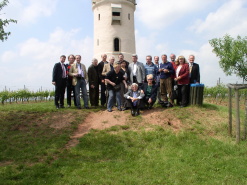 while by 2006 this had risen substantially to nearly 37%. This has now stabilised with white varieties making a comeback, especially the Riesling, every drop of which can be sold. Already Germany is the world’s largest Riesling producer but it seems there is never enough. The USA is now the largest importer of German wines, in fact exports have tripled since 2000. All of them Riesling! 1996 the trade was worth $38,000,000 which has now risen to a staggering $200,000,000. And not many people know that Germany is also the world's third largest producer of Pinot Noir, after France and USA. while by 2006 this had risen substantially to nearly 37%. This has now stabilised with white varieties making a comeback, especially the Riesling, every drop of which can be sold. Already Germany is the world’s largest Riesling producer but it seems there is never enough. The USA is now the largest importer of German wines, in fact exports have tripled since 2000. All of them Riesling! 1996 the trade was worth $38,000,000 which has now risen to a staggering $200,000,000. And not many people know that Germany is also the world's third largest producer of Pinot Noir, after France and USA. The representative tasting that followed did not fail to include such gems long the staple of generations of young uneducated drinkers in northern Europe, who were weaned on Liebfraumilch, Blue Nun and Black Tower. We were pleased to find the quality on the same level as we remembered. Other wines for the export market hit a higher mark. The restaurant Lanskrone offered a la carte selection with a range of wines. 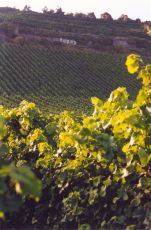 Over to the Roter Hang above Nierstein after lunch, for a much-needed walk among the Riesling vines planted up this very steep slope in iron-rich red soils composed of sandstone and clay and comprising the following vineyards from west to east only: Schloss Schwabsburg, Orbel, Heiligenbaum, Ölberg, Kranzberg, Hipping and Pettenthal. With a south and south-east aspect as well as the steepness protecting the vines from wind and the river surface that causes a warming influence, this is indeed a unique vineyard site. We were escorted by the youthful Konstantin Guntrum, winemaker and Vice-president of Wein von Roten Hang e.V., an association for the 32 wineries with plantings on this site. A tasting of Rieslings from Louis Guntrum and fellow winemaker Stefan Raddeck followed, in a romantic setting overlooking the picturesque town of Nierstein. Nor did rain materialise as had been expected. The young Rieslings in various styles from the two producers were fruity and filled with a steely minerality. Stefan Raddeck is another who rejects as useless the Kabinett, Spätlese and Auslese labellings although his colleague has yet to make the break with the old system. We finished with 1976 Riesling Heiligenbaum Auslese from Louis Guntrum, a rich and very luscious example of an older wine at its best, one of the last 45 bottles remaining in the cellar and not for sale. Incidentally, the oldest bottle in the cellar is the very last of the 1945 vintage. The troops of General Patton had emptied the cellars of all its treasures upon crossing the Rhine earlier that year, which is what Over to the Roter Hang above Nierstein after lunch, for a much-needed walk among the Riesling vines planted up this very steep slope in iron-rich red soils composed of sandstone and clay and comprising the following vineyards from west to east only: Schloss Schwabsburg, Orbel, Heiligenbaum, Ölberg, Kranzberg, Hipping and Pettenthal. With a south and south-east aspect as well as the steepness protecting the vines from wind and the river surface that causes a warming influence, this is indeed a unique vineyard site. We were escorted by the youthful Konstantin Guntrum, winemaker and Vice-president of Wein von Roten Hang e.V., an association for the 32 wineries with plantings on this site. A tasting of Rieslings from Louis Guntrum and fellow winemaker Stefan Raddeck followed, in a romantic setting overlooking the picturesque town of Nierstein. Nor did rain materialise as had been expected. The young Rieslings in various styles from the two producers were fruity and filled with a steely minerality. Stefan Raddeck is another who rejects as useless the Kabinett, Spätlese and Auslese labellings although his colleague has yet to make the break with the old system. We finished with 1976 Riesling Heiligenbaum Auslese from Louis Guntrum, a rich and very luscious example of an older wine at its best, one of the last 45 bottles remaining in the cellar and not for sale. Incidentally, the oldest bottle in the cellar is the very last of the 1945 vintage. The troops of General Patton had emptied the cellars of all its treasures upon crossing the Rhine earlier that year, which is what 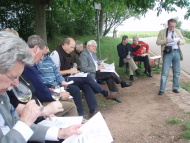 normally happens as the fortunes of war swing first one way then the other. normally happens as the fortunes of war swing first one way then the other.
The final stop was at Stallman-Hiestand in Uelversheim for a 2004 Pinot Extra Brut APERO. This five-generations-old family winery with 16.5 hectares and 33 single vineyard sites is where Werner and son Christoph Hiestand concentrate on autochtonous varieties, mainly the Pinots, Riesling and Silvaner. All grapes are hand-selected and de-stalked. Around 120 000 bottles are produced annually, the majority of them in the dry style. Most of the production is consumed in Germany with only 6% going abroad. The tasting was of Pinots both white and red.
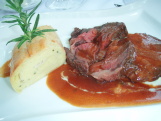 Proceedings concluded at the Restaurant Millennium in nearby Ingelheim where a very successful and educative trip had been reminisced over a gourmet dinner of tuna fish with rucola salad, cream of asparagus soup and veal fillet with chanterelles accompanied by yet more fine wines from the region. Proceedings concluded at the Restaurant Millennium in nearby Ingelheim where a very successful and educative trip had been reminisced over a gourmet dinner of tuna fish with rucola salad, cream of asparagus soup and veal fillet with chanterelles accompanied by yet more fine wines from the region.
You can read more about other FIJEV trips to Germany here 
|


